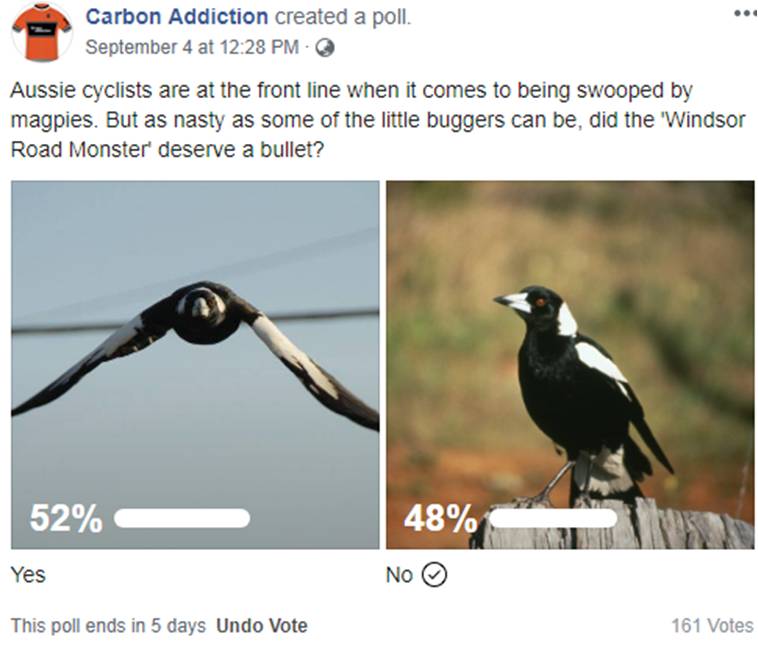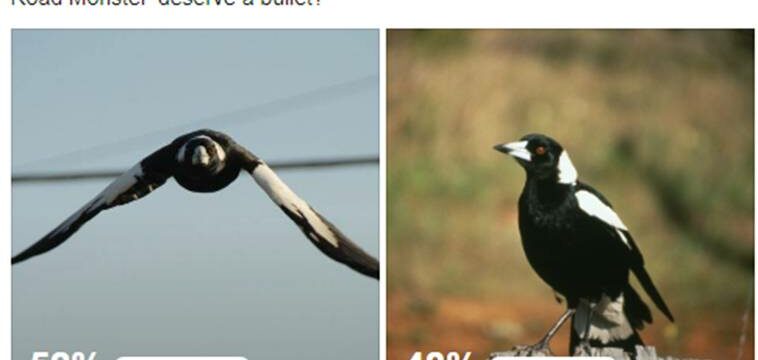Magpies swooping cyclists – do they deserve to be shot?

This week in my home town of Sydney, there was much talk about magpies swooping cyclists and a Sydney municipal council ‘removing’ a magpie that has been attacking cyclists for a number of years. Apparently, there’s been some 40 complaints after three years of attacks so the bird was shot. A friend of mine who writes a cycling blog called Carbon Addiction did an interesting poll on Facebook asking if his followers thought if the hapless bird deserved a bullet and the respondents were close to a 50/50 split.
I’m not here to debate whether this ‘removal’ should have occurred but there are plenty of things you can do to avoid magpie attacks that aren’t quite as extreme.
Spring is an awesome time of the year to ride a bike, it also means that there are a lot of angry birds swooping cyclists in the next couple of months. So I tend to talk about this topic every year because there’s always a lot of interest.
After 11 years of cycling, the most effective deterrent I’ve found is to avoid the area where the known assailants are operating. I know this can be a little inconvenient at times but it is unlikely that too many councils are going to follow the Hills Shire Council in shooting magpies. There’s a very handy website called Magpie Alert that lists known locations so it’s a great place to head if you’re going to take my advice.
Share the information about locations of attacking birds with fellow cyclists via social media, forums, and websites. You could also share the information on Facebook pages for your local cycling group and other ways you communicate with fellow cyclists.
Magpies seem to get most of the mentions, but in my local area there are a couple of very vicious butcherbirds that re-emerge at this time of year to protect their babies.
Native birds such as Australian Magpies are highly protective of their eggs, nest and young and will often swoop at unsuspecting passers-by if they feel threatened. Other native Australian birds that are also common culprits include butcherbirds, kookaburras and plovers, but even invasive species like Indian Mynas can attack at this time of year. Magpies seem to cop the majority of the blame but from my experience butcherbirds are more vicious.
Only a small proportion of birds swoop on people and these often have a preference for a few individuals that the birds recognise or certain types of ‘targets’ like cyclists. A magpie will only defend its nest within a ‘defence zone’. For cyclists, this is usually an area within 150 metres.
Almost all swoops on people are carried out by male birds defending their eggs and chicks, which are in the nest for about six to eight weeks between July and November. They will usually target the head but learn that helmets are there to protect the rider so start to side swoop attacking ears, cheeks, and even eyes.
Here’s a few other tips that might help:
- Most people get more injury from falling off the bike or into oncoming traffic than the actual bird attack so it’s important to stay calm and keep riding
- Consider taking a different route if you know where a ‘swooping’ bird is nesting
- They generally only attack solo cyclists so ride in a tight bunch (not always practical because there’s always going to be a certain amount of riding when you’re on your own)
- Wear sunglasses to protect your eyes
- You may choose to dismount to avoid danger from traffic or from a fall. Once you have dismounted, look at the bird directly; magpies and other birds usually won’t attack when you are watching them.
Here’s what doesn’t work:
- Painting eyes on your helmet is not very effective as magpies have good eyesight and can learn the difference between painted and real eyes
- Putting cable ties on your helmet that stick up to deflect the swooping bird doesn’t appear to work. I’ve found no conclusive evidence in my research and frankly, I’d rather take the risk than look like a dork.

